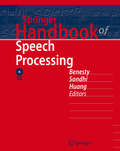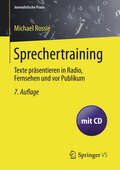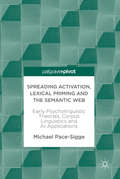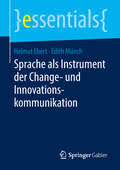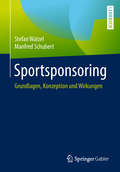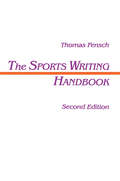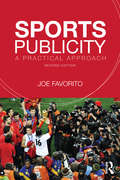- Table View
- List View
Springer Handbook of Speech Processing (Springer Handbooks)
by Jacob Benesty M. Mohan Sondhi Yiteng Arden HuangThis handbook plays a fundamental role in sustainable progress in speech research and development. With an accessible format and with accompanying DVD-Rom, it targets three categories of readers: graduate students, professors and active researchers in academia, and engineers in industry who need to understand or implement some specific algorithms for their speech-related products. It is a superb source of application-oriented, authoritative and comprehensive information about these technologies, this work combines the established knowledge derived from research in such fast evolving disciplines as Signal Processing and Communications, Acoustics, Computer Science and Linguistics.
Springer Handbook of Optical Networks (Springer Handbooks)
by Biswanath Mukherjee Ioannis Tomkos Massimo Tornatore Peter Winzer Yongli ZhaoThis handbook is an authoritative, comprehensive reference on optical networks, the backbone of today’s communication and information society. The book reviews the many underlying technologies that enable the global optical communications infrastructure, but also explains current research trends targeted towards continued capacity scaling and enhanced networking flexibility in support of an unabated traffic growth fueled by ever-emerging new applications. The book is divided into four parts: Optical Subsystems for Transmission and Switching, Core Networks, Datacenter and Super-Computer Networking, and Optical Access and Wireless Networks. Each chapter is written by world-renown experts that represent academia, industry, and international government and regulatory agencies. Every chapter provides a complete picture of its field, from entry-level information to a snapshot of the respective state-of-the-art technologies to emerging research trends, providing something useful for the novice who wants to get familiar with the field to the expert who wants to get a concise view of future trends.
Sprechertraining: Texte präsentieren in Radio, Fernsehen und vor Publikum (Journalistische Praxis)
by Michael Rossié"Sprechertraining" lautet nicht nur der Buchtitel, es handelt sich wirklich um ein allgemein verständliches Trainingsprogramm zur Präsentation von Texten in den Medien mit praktischen Beispielen und Übungen. Vom einfachen Zwei-Wort-Satz bis zu schwierigen Satzkonstruktionen wird der zukünftige Sprecher sowohl mit den Grundlagen als auch mit den vielen Problemen und Sonderfällen von hörerbezogenem Lesen vertraut gemacht. Für die achte Auflage wurde der Band durchgesehen, ergänzt und Beispiele wurden aktualisiert.
Sprechertraining: Texte präsentieren in Radio, Fernsehen und vor Publikum (Journalistische Praxis)
by Michael Rossié"Sprechertraining" lautet nicht nur der Buchtitel, es handelt sich wirklich um ein allgemein verständliches Trainingsprogramm zur Präsentation von Texten in den Medien mit praktischen Beispielen und Übungen. Vom einfachen Zwei-Wort-Satz bis zu schwierigen Satzkonstruktionen wird der zukünftige Sprecher sowohl mit den Grundlagen als auch mit den vielen Problemen und Sonderfällen von hörerbezogenem Lesen vertraut gemacht (mit mehr als 80 Hörbeispielen auf CD).
Spreadsheet Layout (UEB uncontracted)
by RnibThis page shows the layout of a typical simple spreadsheet. There is a locator dot shown, which will be at the top left of the page when the image is the right way up. The uncontracted (grade 1) braille version of this diagram is a multi-page image set on two pages. The page is filled by a table with four columns and ten rows, making a total of forty cells. The top row of four cells contains column headings and the remaining cells contain data. The columns headings are, from left to right, ID, Name, Description, and Picture.
Spreadsheet Layout (UEB contracted)
by RnibThis page shows the layout of a typical simple spreadsheet. There is a locator dot shown, which will be at the top left of the page when the image is the right way up. The uncontracted (grade 1) braille version of this diagram is a multi-page image set on two pages. The page is filled by a table with four columns and ten rows, making a total of forty cells. The top row of four cells contains column headings and the remaining cells contain data. The columns headings are, from left to right, ID, Name, Description, and Picture.
Spreadsheet Layout (large print)
by RnibThis page shows the layout of a typical simple spreadsheet. There is a locator dot shown, which will be at the top left of the page when the image is the right way up. The uncontracted (grade 1) braille version of this diagram is a multi-page image set on two pages. The page is filled by a table with four columns and ten rows, making a total of forty cells. The top row of four cells contains column headings and the remaining cells contain data. The columns headings are, from left to right, ID, Name, Description, and Picture.
Spreading Activation, Lexical Priming and the Semantic Web (PDF)
by Michael Pace-SiggeThis book explores the interconnections between linguistics and Artificial Intelligence (AI) research, their mutually influential theories and developments, and the areas where these two groups can still learn from each other. It begins with a brief history of artificial intelligence theories focusing on figures including Alan Turing and M. Ross Quillian and the key concepts of priming, spread-activation and the semantic web. The author details the origins of the theory of lexical priming in early AI research and how it can be used to explain structures of language that corpus linguists have uncovered. He explores how the idea of mirroring the mind’s language processing has been adopted to create machines that can be taught to listen and understand human speech in a way that goes beyond a fixed set of commands. In doing so, he reveals how the latest research into the semantic web and Natural Language Processing has developed from its early roots. The book moves on to describe how the technology has evolved with the adoption of inference concepts, probabilistic grammar models, and deep neural networks in order to fine-tune the latest language-processing and translation tools. This engaging book offers thought-provoking insights to corpus linguists, computational linguists and those working in AI and NLP.
Spreading Activation, Lexical Priming and the Semantic Web: Early Psycholinguistic Theories, Corpus Linguistics And Ai Applications
by Michael Pace-SiggeThis book explores the interconnections between linguistics and Artificial Intelligence (AI) research, their mutually influential theories and developments, and the areas where these two groups can still learn from each other. It begins with a brief history of artificial intelligence theories focusing on figures including Alan Turing and M. Ross Quillian and the key concepts of priming, spread-activation and the semantic web. The author details the origins of the theory of lexical priming in early AI research and how it can be used to explain structures of language that corpus linguists have uncovered. He explores how the idea of mirroring the mind’s language processing has been adopted to create machines that can be taught to listen and understand human speech in a way that goes beyond a fixed set of commands. In doing so, he reveals how the latest research into the semantic web and Natural Language Processing has developed from its early roots. The book moves on to describe how the technology has evolved with the adoption of inference concepts, probabilistic grammar models, and deep neural networks in order to fine-tune the latest language-processing and translation tools. This engaging book offers thought-provoking insights to corpus linguists, computational linguists and those working in AI and NLP.
Sprachverstehen und Textinterpretation: Grundzüge einer verstehenstheoretisch reflektierten interpretativen Semantik
by Dietrich BusseDietrich Busse widmet sich den theoretischen Grundlagen einer Erklärung von Sprachverstehen und Textinterpretation. Gleich in welchem Bereich oft stellen sich denjenigen, die es mit der Interpretation und dem Problem des adäquaten Verstehens von Texten und sprachlichen Äußerungen zu tun haben, die gleichen Fragen: Versuchen wir eine „Mitteilungsabsicht“ des Textautors herauszufinden oder gibt es eine „objektive Textbedeutung“? Kann man die Bedeutung sprachlicher Zeichen überhaupt „objektiv feststellen“ oder liegt in jeder Textauslegung ein „subjektives“ Moment? Der Autor zielt auf eine genuin interpretative bzw. verstehensorientierte Semantik und Textverstehenstheorie, deren Grundlagen er klären will.
Sprachkompetenz, Tageszeitungsnutzung und Politikorientierung von Einwanderern
by Jens VogelgesangEinwanderer nutzen in ihrem Alltag sowohl die Massenmedien der Herkunfts- als auch der Einwanderungsgesellschaft. Am Beispiel der ersten türkischen, italienischen, griechischen und ex-jugoslawischen Einwanderergeneration untersucht Jens Vogelgesang, wie sich einerseits das Beherrschen der deutschen Sprache auf die Tageszeitungsnutzung und andererseits die Tageszeitungsnutzung auf die Politikorientierung der Einwanderer auswirkt.
Sprache und Sprechen im Kontext von Migration: Worüber man sprechen kann und worüber man (nicht) sprechen soll (Interkulturelle Studien)
by Hans-Joachim Roth Henrike Terhart Charis AnastasopoulosDer sprachliche Umgang mit Migration ist nicht selten Gegenstand von Auseinandersetzungen: Was wird gesagt? Was wird nicht gesagt? Wie wird es gesagt? Was darf und was darf nicht gesagt werden? Anliegen der Autorinnen und Autoren ist es aufzudecken, auf welche Weise „Sprache“ und „Sprechen“ im Kontext von Migration – als Gegenstand und als Medium – wirken. Aus der Perspektive der interkulturellen Bildungsforschung und der sozialwissenschaftlichen Migrationsforschung wird analysiert, wie sich sprachliche Hegemonie ausprägt und welche Macht Sprache entfalten kann. Die Beiträge diskutieren zum einen die Rechtmäßigkeit von Sprache(n) und Sprechen sowie dessen Reglementierung und führen zum anderen exemplarisch Untersuchungsmöglichkeiten in der Migrationsforschung vor.
Sprache und Dialog als Führungsinstrumente: Wie Gespräche die Organisationsentwicklung der Zukunft sichern
by Helmut EbertDieses Buch beschreibt, wie die Kunst des Gesprächeführens als Mittel der erfolgreichen Organisationsentwicklung und in Veränderungsprozessen genutzt werden kann und welche Ansatzpunkte es dazu gibt. Denn im Normalfall ist uns nicht bewusst, was wir sprechend tun. Organisationale Veränderungen im Großen und Kleinen können nur in echten Gesprächen gelingen, die Denkräume für Neues und Denkräume der Besonnenheit eröffnen – insbesondere in Zeiten der Digitalisierung aller Unternehmensbereiche. Es gilt durch das, was andere sagen und wie sie sich verhalten, besser auf deren Innenwelt zu schließen. Verantwortliche in Unternehmen können dadurch einen guten und kooperativen Kontakt mit allen Mitarbeitern und Stakeholdern herstellen und halten.Der Autor zeigt auf, wie wichtig es ist, den Dialog zu suchen, Empathie und Wertschätzung zu zeigen, Emotionen zu erkennen, und beschreibt, mit welchen Mitteln das erreicht werden kann.Er liefert wichtige theoretische Hintergründe und unterstützt Sie, eine individuelle Strategie für Gespräche in Ihrem Unternehmen zu entwickeln, um auch in Zukunft erfolgreich zu sein.
Sprache, Kultur und Zielgruppen: Bedingungsgrößen für die Kommunikationsgestaltung in der Wirtschaft (Europäische Kulturen in der Wirtschaftskommunikation)
by Christopher M. Schmidt Dagmar NeuendorffDer Band befasst sich u.a. mit Aspekten der Kommunikationsgestaltung und -effektivierung sowohl innerhalb von Unternehmen als auch im Wechselspiel mit kulturell unterschiedlichen Märkten. Es werden Grundsatzfragen interkultureller Kommunikationsgestaltung in und von Unternehmen sowohl aus theoretischer als auch aus vielseitiger anwendungsbezogener Perspektive unter Berücksichtigung der Zielgruppenadäquatheit behandelt.
Sprache in den Medien (Medienwissen kompakt)
by Gunter ReusSeit es Massenmedien gibt, machen Kulturkritiker sie verantwortlich für einen vermeintlichen Verfall der Sprache. Doch eine solche Anschuldigung ist unhaltbar. Sprache verändert sich ständig, weil sich die Gesellschaft wandelt. Massenmedien greifen diese Veränderungen in Wortschatz und Syntax auf und spiegeln sie in die Gesellschaft zurück. Motor und Ursprung von „Sprachverderb“ aber sind sie keineswegs. Vielmehr erschließen sie der Gesellschaft Vielfalt und Reichtum von Ausdrucksmöglichkeiten. Sie machen Sprache als Kulturleistung zugänglich und die Welt mit Sprache verständlich.
Sprache im Exil: Mehrsprachigkeit und Übersetzung als literarische Verfahren bei Hilde Domin, Mascha Kaléko und Werner Lansburgh (Exil-Kulturen #2)
by Anne BentelerDie Monographie untersucht Sprachkonstellationen in der Literatur des Exils aus NS-Deutschland seit 1933. Im Fokus stehen mehrsprachige Texte von Hilde Domin, Mascha Kaléko und Werner Lansburgh. Die Kombination eines kulturwissenschaftlich geprägten Übersetzungsbegriffs mit Ergebnissen linguistischer Mehrsprachigkeitsforschung macht zwei höchst aktuelle Wissenschaftsdiskurse für die Analyse von literarischen Textphänomenen produktiv. Die Untersuchung erweist, dass die Texte Domins, Kalékos und Lansburghs durch Sprachreflexion, Code-Switchings und Sprachmischungen bestimmt sind. Die Vorstellung einer monolingualen Literatursprache und Nationalliteratur wird dadurch infrage gestellt und es zeigt sich, dass die meist biografisch argumentierenden Vorstellungen von Sprachbewahrung und Sprachverlust im Exil durch alternative Entwürfe von Exilliteratur als translingualem und translationalem Reflexionsraum zu ergänzen sind.
Sprache als Instrument der Change- und Innovationskommunikation (essentials)
by Helmut Ebert Edith MünchDieses essential zeigt, wie Sie mit Sprache Umbrüche meistern und neue Ideen entwickeln. Denken ist ein kreativer Umgang mit Bedeutungen. Die Verfahren für Ideenspielräume: definieren, abstrahieren, metaphorisieren, negieren, rahmen („framing“) sowie argumentieren, erzählen, beschreiben. Die Vorfeldfaktoren: Empathie, informale Kommunikation, Akzeptanz von Ungewissheit und Mehrdeutigkeit, experimentelle Haltung, Perspektivenabgleich, Überwindung von Tabus, Mythen und blockierenden inneren Bildern - und eine Sprache, die Gruppen befähigt, von der Zukunft her zu denken.
Spotify For Dummies
by Kim GilmourThe ultimate beginner guide to the groundbreaking music service, Spotify! Spotify is a free online streaming music platform that allows users to listen to songs on demand over the Internet--without having to buy or own the actual tracks. This fun and friendly guide walks you through how best to use this sweet-sounding service. Covering everything from using Spotify on selected mobile phones to creating and sharing your own playlists, Spotify For Dummies has it all. Experienced author Kim Gilmour details the ins and outs of this revolutionary music, from installing and setup to discovering new artists and taking your musical enjoyment to new levels. Explores the social networking aspects of Spotify and how to integrate with them Helps you navigate through the various editions of Spotify Shows you how to take Spotify with you on your mobile device Encourages you to merge your own music collection with Spotify This book is spot on! Start using Spotify today with this handy guide by your side.
Spotify For Dummies
by Kim GilmourThe ultimate beginner guide to the groundbreaking music service, Spotify! Spotify is a free online streaming music platform that allows users to listen to songs on demand over the Internet--without having to buy or own the actual tracks. This fun and friendly guide walks you through how best to use this sweet-sounding service. Covering everything from using Spotify on selected mobile phones to creating and sharing your own playlists, Spotify For Dummies has it all. Experienced author Kim Gilmour details the ins and outs of this revolutionary music, from installing and setup to discovering new artists and taking your musical enjoyment to new levels. Explores the social networking aspects of Spotify and how to integrate with them Helps you navigate through the various editions of Spotify Shows you how to take Spotify with you on your mobile device Encourages you to merge your own music collection with Spotify This book is spot on! Start using Spotify today with this handy guide by your side.
Sportsponsoring: Grundlagen, Konzeption und Wirkungen
by Stefan Walzel Manfred SchubertSportsponsoring ist die mit Abstand bedeutendste Erscheinungsform des Sponsorings. Es zählt zu den zentralen Instrumenten der Markenkommunikation von Unternehmen und zugleich zu den wichtigsten Einnahmequellen des Zuschauersports. Das Lehrbuch stellt Sportsponsoring als Kommunikations- und Finanzierungsinstrument in seiner ganzen Breite und Vielfalt vor. Thematisiert werden u.a. Akteure und Zielgruppen, die Erfolgs- und Wirkungskontrolle von Sportsponsoring-Maßnahmen, unerwünschte Effekte wie Ambush-Marketing sowie die soziale Verantwortung von Sponsoren und Gesponserten. Das Buch bietet eine gute Einführung für Studierende, enthält aber auch wertvolle Informationen für ehren- oder hauptamtlich Tätige im Sport und für Marketingmanager in Unternehmen. Lernziele, Verständnis- und Diskussionsfragen, Zusammenfassungen sowie weiterführende Links und Literaturempfehlungen zu jedem Kapitel erleichtern die Nutzung des Buches, sichern den Lernerfolg und regen zur vertiefenden Auseinandersetzung mit einzelnen Themen an.
The Sports Writing Handbook
by Thomas FenschCompletely revised and updated in a second edition, this volume represents the only book ever written that analyzes sports writing and presents it as "exceptional" writing. Other books discuss sports writers as "beat reporters" in one area of journalism, whereas this book shows aspiring sports writers a myriad of techniques to make their writing stand out. It takes the reader through the entire process of sports writing: observation, interviewing techniques, and various structures of articles; types of "leads;" transitions within an article; types of endings; use of statistics; do's and don'ts of sports writing; and many other style and technique points. This text provides over 100 examples of leads drawn from newspapers and magazines throughout the country, and also offers up-to-date examples of sports jargon from virtually every major and minor sport played in the U.S.
The Sports Writing Handbook
by Thomas FenschCompletely revised and updated in a second edition, this volume represents the only book ever written that analyzes sports writing and presents it as "exceptional" writing. Other books discuss sports writers as "beat reporters" in one area of journalism, whereas this book shows aspiring sports writers a myriad of techniques to make their writing stand out. It takes the reader through the entire process of sports writing: observation, interviewing techniques, and various structures of articles; types of "leads;" transitions within an article; types of endings; use of statistics; do's and don'ts of sports writing; and many other style and technique points. This text provides over 100 examples of leads drawn from newspapers and magazines throughout the country, and also offers up-to-date examples of sports jargon from virtually every major and minor sport played in the U.S.
The Sports Strategist: Developing Leaders for a High-Performance Industry
by Irving Rein Ben Shields Adam GrossmanToday's high-performance sports business is more complex than ever before and presents new challenges to the industry at all levels. Sports organizations are fighting hard for the money and engagement of fans, media, and sponsors while facing unprecedented competition both domestically and internationally. The cost of doing business continues to rise, while traditional revenue streams are under increased pressure. In The Sports Strategist: Developing Leaders for a High-Performance Industry, authors Irving Rein, Ben Shields, and Adam Grossman demonstrate that relying too much on winning is a losing long-term strategy for dealing with these challenges. Instead, they argue that sports organizations must focus on identifying and maximizing key factors that, unlike winning, can be controlled and shaped. By building a more well-rounded business, sports strategists will position themselves and their organizations for sustainable success in the industry. Blending extensive industry experience and real-world case studies with their academic expertise, the authors arm students with the combination of the necessary tools to help them make better strategic decisions. Students will learn how to design identities, reinvigorate venue experiences, manage narratives, and maximize new technology in today's connected world. In addition, readers will explore how to implement business analytics, build public support, and apply ethics in decision-making. These techniques are vital to creating a successful sports organization that is ready to reap the benefits of winning when it does happen, without having to suffer when it does not. The demand for innovative leaders who can address these issues and make tough decisions on which challenges to prioritize has never been greater. The Sports Strategist is an essential resource for anyone looking to thrive in the sports industry.
Sports Publicity: A Practical Approach
by Joe FavoritoEffective communications skills are essential for any organization. In this fully revised and updated edition of his groundbreaking guide to communications in sports, Joe Favorito introduces the skills, knowledge and techniques needed to become a successful communicator. Drawing on nearly thirty years of professional experience, including work with the International Baseball Federation, New York Knicks, Philadelphia 76ers, Bloomberg Sports and the US Tennis Association, as well as projects with the NFL, USOC, NASCAR, MLB, MLS and many other elite groups and brands in sports and entertainment, Favorito outlines the history of sports communications, explores all the most important professional themes, topics and issues, and highlights exciting opportunities for future growth and development. With a strong emphasis on professional practice and the day-to-day realities of working in sports and entertainment, the book covers all the core functional areas such as: Effective writing and speaking Building and Marketing brands Developing contacts and networks Social and Digital Media Strategy Gaining experience and internships Crisis management Successful pitching Press conferences Working with individual athletes, teams and league organizations Agents, Broadcast Networks and Agencies Understanding the global sports market The second edition includes brand new material on using social media, gaming, and brand integration, as well as extended real-world case studies and interviews with trailblazing PR professionals. No other book offers such a valuable insider’s view of the sports communications industry or the importance of PR and media relations in building successful sports organizations. Sports Publicity is essential reading for all students working in sport business, marketing or communications, and any PR practitioner looking to improve their professional skills and technique.
